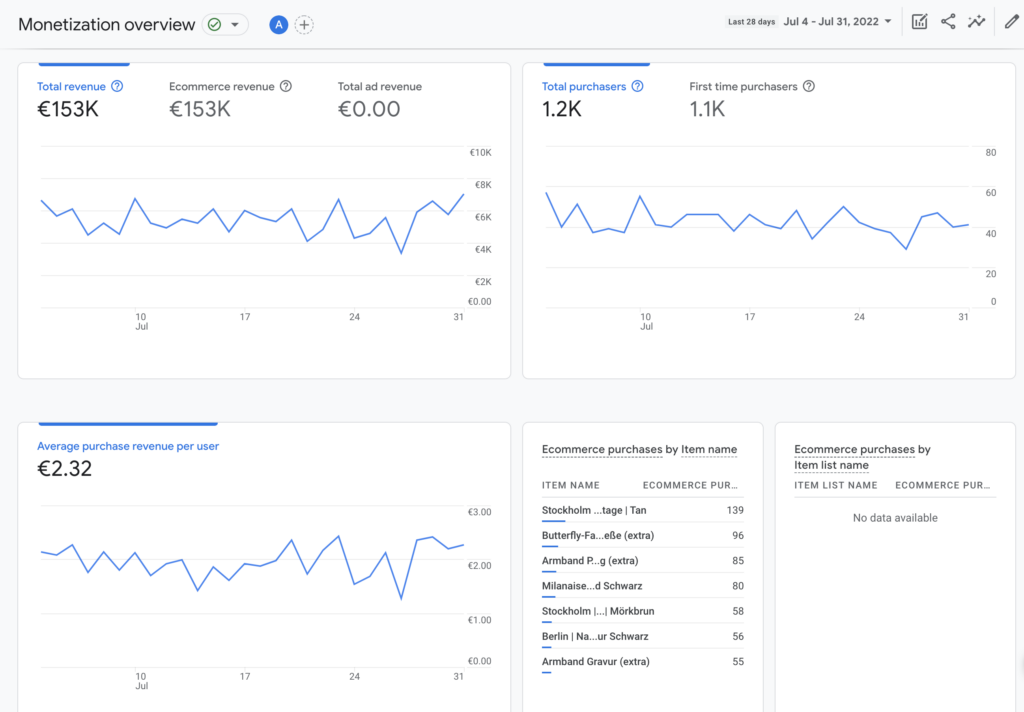Online retailers often grapple with understanding how well their e-commerce business is performing. Did you know that tracking specific metrics can provide valuable insights and facilitate data-driven decisions? This article dives into the most crucial e-commerce metrics, from conversion rates to customer acquisition costs, equipping you with knowledge for informed decision-making.
Ready to take your online retail store’s performance up a notch? Dive in!
Key Takeaways
- Tracking e-commerce metrics such as sales conversion rate, average order value, and customer acquisition costs can provide valuable insights to online retailers.
- Understanding these metrics helps businesses identify areas for improvement and make data-driven decisions to drive sales growth.
- Utilizing analytics tools like Google Analytics or Shopify Analytics, and implementing tracking codes on websites are effective ways to accurately track e-commerce metrics.
Key E-commerce Metrics for Online Retailers
The key e-commerce metrics for online retailers include the sales conversion rate, average order value, customer lifetime value, customer acquisition costs, and shopping cart abandonment rate.
Sales conversion rate
Sales conversion rate is a crucial e-commerce metric that measures the percentage of website visitors who make a purchase. A high sales conversion rate signifies efficient marketing and a user-friendly website, indicating that customers are finding what they need quickly and easily.
Companies can improve their sales conversion rates by using various strategies such as optimizing product pages, reducing checkout friction, and offering personalized product recommendations.
This metric serves as an essential tool in understanding your business’s online performance while simultaneously identifying areas for improvement to drive sales growth.

Average order value
The average order value is a key metric that online retailers need to track in order to evaluate the effectiveness of their sales strategies. It refers to the average amount spent by customers on each transaction.
By monitoring this metric, businesses can gain insights into customer purchasing behavior and identify opportunities for revenue growth. A high average order value indicates that customers are spending more per purchase, which can boost profitability.
On the other hand, a low average order value may suggest the need for targeted marketing campaigns or upselling tactics to increase customer spending. By analyzing and optimizing this metric, online retailers can drive higher sales volumes and ultimately improve their bottom line.
Customer lifetime value
Customer lifetime value is a crucial e-commerce metric that measures the total value a customer brings to your business over their lifetime. It takes into account not just the initial purchase but also repeat purchases and the potential for upselling or cross-selling.
By calculating customer lifetime value, you can understand how much revenue each individual customer generates for your business and make informed decisions on marketing strategies, pricing, and customer retention efforts.
Understanding this metric helps you prioritize valuable customers and allocate resources effectively to maximize long-term profitability.
Customer acquisition costs
Calculating and monitoring customer acquisition costs is vital for online retailers. These costs refer to the expenses incurred in attracting new customers to your e-commerce store.
By analyzing these metrics, businesses can determine how much they are spending on acquiring each customer. This information allows them to make informed decisions about marketing strategies and optimize their budgets effectively.
Understanding customer acquisition costs helps online retailers assess the profitability of different channels and campaigns, enabling them to allocate resources efficiently and maximize their return on investment (ROI).
Shopping cart abandonment rate
The shopping cart abandonment rate is a crucial metric for online retailers. It measures the percentage of shoppers who add items to their carts but then leave the website without making a purchase.
By tracking this metric, businesses can gain insights into potential issues and optimize their checkout process to reduce abandonment rates. High abandonment rates may indicate problems like hidden fees, complicated checkout steps, or lack of trust in the website’s security.
Analyzing and improving this metric can help businesses increase their conversion rates and ultimately boost their sales revenue.
Importance of E-commerce Metrics for Business Success
E-commerce metrics are crucial for the success of online retailers as they provide valuable insights and data that can be used to understand performance, improve forecasting, and analyze website engagement.
Understand performance
Tracking and understanding the performance of your e-commerce business is crucial for success. By analyzing key metrics such as sales conversion rate, average order value, customer lifetime value, and customer acquisition costs, you can gain valuable insights into how your online store is performing.
These metrics provide a clear picture of how effective your marketing efforts are in driving sales and acquiring new customers. Understanding your performance allows you to make data-driven decisions and optimize your strategies to improve profitability and drive growth.
Improve forecasting
Improving forecasting is crucial for online retailers to accurately predict future sales and plan their inventory accordingly. By analyzing e-commerce metrics such as sales conversion rate, average order value, customer lifetime value, and customer acquisition costs, businesses can gain valuable insights into consumer behavior and trends.
This data enables them to make informed decisions about marketing strategies, product offerings, and pricing models. With better forecasting capabilities, online retailers can optimize their operations and stay ahead of the competition in a rapidly evolving digital marketplace.

Analyze website engagement
To gauge the effectiveness of your online retail business, it’s crucial to analyze website engagement. By examining user behavior and interactions on your website, you can gain valuable insights into how well your site is performing and identify areas for improvement.
Look at metrics such as page views, time spent on site, bounce rate, and click-through rates to assess user engagement. These metrics will help you understand how users navigate through your site and whether they are staying engaged or leaving too soon.
How to Track E-commerce Metrics
To track e-commerce metrics, online retailers can utilize analytics tools, such as Google Analytics, to gather and analyze data on sales performance, user engagement, and website traffic.
Additionally, platforms like Shopify offer built-in analytics features that provide valuable insights into key metrics. Implementing tracking codes on your website can also help monitor customer behavior and measure the effectiveness of marketing campaigns.
Utilize analytics tools
Utilize analytics tools to track and measure your e-commerce metrics effectively. These tools provide valuable insights into your website’s performance, user engagement, and sales conversion rates.
By analyzing data such as website traffic, average order value, and customer acquisition costs, you can make informed decisions to optimize your online retail business. With the help of analytics tools like Shopify Analytics or implementing tracking codes, you can stay on top of key performance indicators (KPIs) and identify areas for improvement.
Don’t miss out on the opportunity to harness the power of data analysis to drive success in your e-commerce endeavors.
Use Shopify Analytics
To effectively track and analyze your e-commerce metrics, consider utilizing Shopify Analytics. This powerful tool provides valuable insights into the performance of your online retail business.
With Shopify Analytics, you can easily monitor key metrics such as sales conversion rate, average order value, and customer lifetime value. The platform also allows you to track customer acquisition costs and analyze shopping cart abandonment rates.
By leveraging Shopify Analytics, you can make informed decisions to optimize your e-commerce strategy and drive business growth.

Implement tracking codes
Implementing tracking codes is crucial for online retailers to gather accurate and comprehensive data about their website visitors. These codes, embedded in your website’s HTML or JavaScript, allow you to track user behavior, monitor conversions, and gain insights into the effectiveness of your marketing campaigns.
By implementing tracking codes from tools like Google Analytics or Facebook Pixel, you can measure key metrics such as page views, click-through rates, and conversion rates. This data will help you make informed decisions when it comes to optimizing your website performance and improving your overall online retail strategy.
Conclusion
In conclusion, tracking e-commerce metrics is crucial for online retailers to understand their performance and make informed decisions. By monitoring key data points like sales conversion rate, average order value, customer lifetime value, and shopping cart abandonment rate, businesses can optimize their strategies and improve overall success.
Utilizing analytics tools and implementing tracking codes are effective ways to track these metrics accurately. Stay on top of your e-commerce metrics to drive growth and achieve your business goals.
Frequently Asked Questions
1. What are e-commerce metrics?
E-commerce metrics are data points used by online retailers to track sales performance, customer retention rate, average order value (AOV), customer acquisition cost (CAC) and return on investment (ROI).
2. Why is tracking e-commerce KPIs important?
Tracking e-commerce Key Performance Indicators (KPIs) such as user engagement metrics, conversion rate optimization, and average transaction value helps businesses monitor their marketing effectiveness and financial health.
3. How can an eCommerce metrics dashboard improve my business performance?
An eCommerce metrics dashboard provides a clear overview of your website traffic analysis, email opt-in rates, and other key data points that help in making informed decisions to enhance your online retail operations.
4. Can eCommerce analytics increase customer loyalty?
Yes! E-commerce analytics that focuses on customer lifetime value(CLTV), retention rates, and email marketing effectiveness can greatly help in improving customer loyalty.
5. What’s the role of performance tracking in managing e-commerce financial metrics?
Performance tracking allows online retailers to optimize their budget allocation by giving insights into ROI while also keeping tabs on important aspects like Customer Acquisition Cost(CAC), aiding effective management of e-commerce financial Metrics.


